Doetinchem 作者: 来源: 发布时间:2021-06-29
I. Population and Area
Location in Gelderland
Coordinates: 51°58′N 6°18′E
Country Netherlands
Province Gelderland
Area
• Total 79.66 km2 (30.76 sq mi)
• Land 79.06 km2 (30.53 sq mi)
• Water 0.60 km2 (0.23 sq mi)
Elevation 14 m (46 ft)
Population (January 2019)
• Total 57,555
• Density 728/km2 (1,890/sq mi)
Demonym(s) Doetinchemmer
Time zone UTC+1 (CET)
• Summer (DST) UTC+2 (CEST)
Postcode
7000–7011, 7030–7031
Area code 0314, 0315
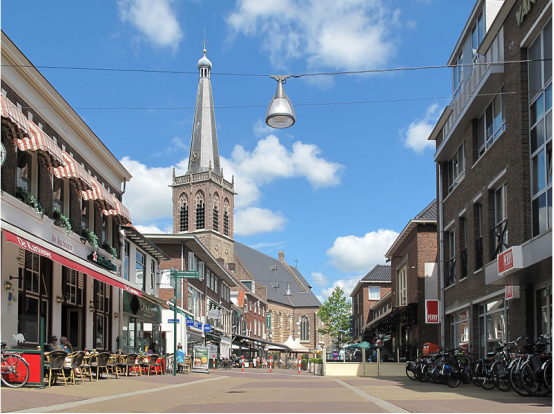
II Geographical features
Doetinchem has been connected to the Dutch national highway system since November 1974, when the Zevenaar-Doetinchem section of Highway 15 (A15) was opened. This section was extended to Varsseveld in 1984. Today the A15 is called the A18.
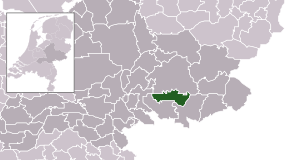
Doetinchem is served by rail services from Arnhem by the regional train to Winterswijk with two stations, one in the city centre – Doetinchem and Doetinchem De Huet lying to the west between the suburbs of De Huet and Dichteren. Doetinchem receives four trains per hour to Arnhem (Monday to Friday) and there are always 2 trains per hour between Arnhem and Winterswijk. In 2012, Arriva, took over the rail services between Arnhem and Winterswijk from NS and Syntus
Doetinchem railway station
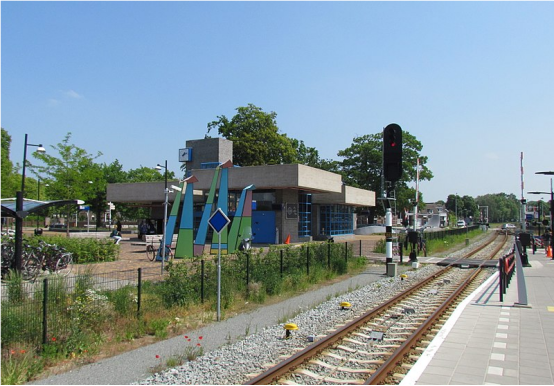
Doetinchem is a railway station located in Doetinchem, Netherlands. The station was opened on 15 July 1885 and is located on the Winterswijk–Zevenaar railway. The station is operated by Arriva and Breng. In Doetinchem there is also Doetinchem De Huet railway station to the west of this station. From 1885-1937, it was also the start of the branch to Ruurlo. From Doetinchem station it is a 10-minute walk north to the town centre. In a Railpro survey in 2005, there were approximately 3590 passengers per day using Doetinchem station.
Doetinchem De Huet railway station
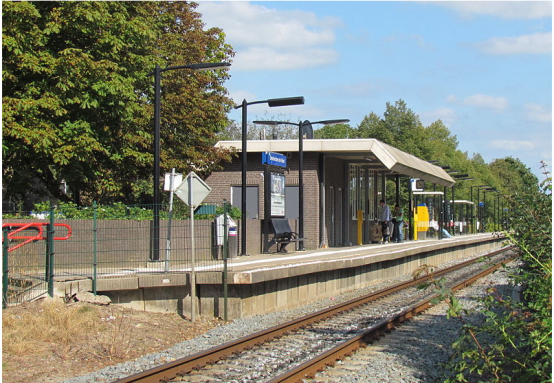
Doetinchem De Huet is a railway station located in western Doetinchem, Netherlands. The station lies between the quarters De Huet and Dichteren. The station was opened on 2 June 1985 as a replacement for the previous station Doetinchem West (earlier: Doetinchem-Wijnbergen (1885-1965)), which was open from 1885-1985. It's located on the Winterswijk–Zevenaar railway. Train services are operated by Arriva and Breng. In a Railpro survey in 2005 there were approximately 1,232 passengers per day using Doetinchem De Huet station.
III Economy
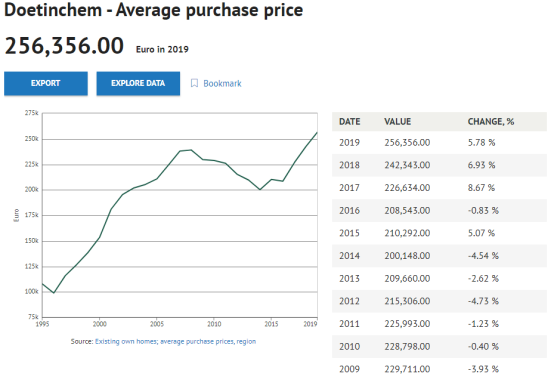
Total male and female - Doetinchem - Net corrections » Net other corrections
-4.00
Number in 2019
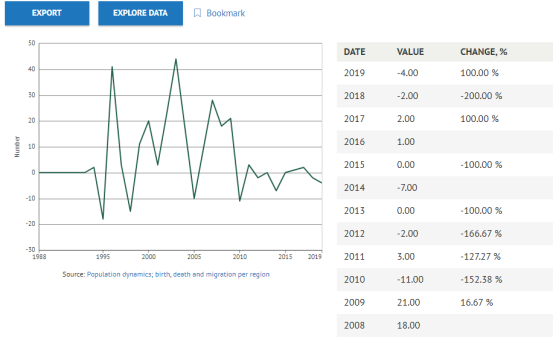
IV Industrial Projects
Area development Europaweg
The Europaweg and the surrounding area are very important for surrounding neighborhoods and visitors to Doetinchem and surroundings. To maintain this for the future, the municipality has been working on a new area elaboration for some time now, in which all future developments have been incorporated. Local residents and other interested parties were able to take note of an initial draft of the area development and give their suggestions for the first time on 23 June 2015 during a walk-in evening in Dichteren .
These plans have now been further elaborated and both the Executive Board and the Board have taken a decision on this.
Doubling Europaweg
The main decisions already taken by the city council in recent years regarding the Europaweg are:
Double the lane between the connection to the A18 and the level crossing to improve traffic flow.
Construction of two-lane roundabouts for traffic flow.
Removing ground-level intersections from motorized and slow traffic (separating traffic flows), so that a safe situation is created for all road users.
Construction of a Sicco Mansholtweg / Wals bicycle tunnel (completed) for a safe crossing of the Europaweg for slow traffic.
Status May 2020: On December 19, 2019, the city council adopted the amended zoning plan. The amended zoning plan makes it possible to double the Europaweg. In February 2020, the final design was adopted by the Municipal Executive.
The first preparatory work has now started. Felling of trees started in March 2020. The existing trees are spared if they are vital and fall outside the road and work profile. However, research shows that many trees are not vital. The tree cutting is amply compensated. New trees have already been planted. A total of 113 trees are cut down and 400 trees are planted.
Utilities will commence in June 2020. They will move cables and pipelines in preparation for the actual road works on the Europaweg. The inconvenience to road traffic is kept to a minimum and detours are not necessary for this work.
Interested in hotel development
Hotel group Van der Valk wants to develop a hotel restaurant at the Europaweg.
Status January 2020 : in response to an application for the realization of a hotel Van der Valk on the Europaweg (corner Kilderseweg), the municipality of Doetinchem submitted a draft environmental permit for inspection at the beginning of 2019. Based on the submitted views, it was decided to supplement the underlying documents. In addition, the city council has been requested to agree to the associated procedure. From late 2019 to mid-January 2020, a draft environmental permit has been available for inspection for a second round. In time, the municipality will take a final decision on the application, also after consideration of the views submitted.
Preparatory work for the solar park
In order to be energy neutral in 2030, the municipality of Doetinchem offers space next to the Europaweg for the development of a park with solar panels. Local residents are involved in the development. The Commission is also focusing on a combination with a run-off area for the adjacent residential areas.
Status November 2019 : the citizens' cooperative Zonneklaar was established after the summer. The cooperative is busy finalizing the financial picture and setting up a communication strategy. Finishing financially is still a challenge given the social character of the park and the investment required at the front. As soon as the financial part is ready, the communication process starts looking for interested members. The zoning plan will be brought into proceedings at the end of December.
Dichterseweg / Wijnbergseweg
From June 2020, the Dichterseweg and Wijnbergseweg will be redesigned. It concerns the section between the parking lot Varkensweide and the section along the Bleek. Bicycle lanes are made on the Wijnbergseweg. A safe crossing will be constructed for cyclists to and from the cycle path on the Stokhorstweg. Contractor Dostal Wegenbouw from Vorden carries out the work on behalf of the municipality of Doetinchem.
Fiberglass Achterhoek
April 2019, the construction of fiber optic has started in the rural area of the municipality of Doetinchem. Doetinchem is part of the Achterhoek South. Here, contractor BAM installs fiber optic in the rural area on behalf of Fiber Optic outside. BAM enters the municipality from the south at Gaanderen. In the rural area on the Wehl side, work will start mid-year. In total, some 4000 addresses are connected in the Achterhoek South, of which about 1450 belong to the municipality of Doetinchem.
Reference: https://www.doetinchem.nl
V Significant structures in Doetinchem
The main church in the central square, St Catherine's Church ('Catharinakerk') was virtually destroyed in the World War II bombing and restoration took from 1948 to 1963. Although originally a Roman Catholic church, it became Dutch Reformed in 1591. There are two castles, 'De Kelder' ('The Cellar') and Slangenburg.
The city has three windmills. In the city centre, there is the already mentioned De Walmolen, the bottom of which now houses the city's tourist office. In Dichteren, there is a mill called Aurora (Latin for 'dawn') and to the east of the city a mill called Benninkmolen. All these mills are open to visitors, usually open to all one weekday morning and at other times by appointment.
A few other important buildings in the city are the Amphion-Theater, the Gruitpoort, a big cultural centre, the Rietveld Lyceum, the biggest high school in Doetinchem and the Tax administration office.
VI History
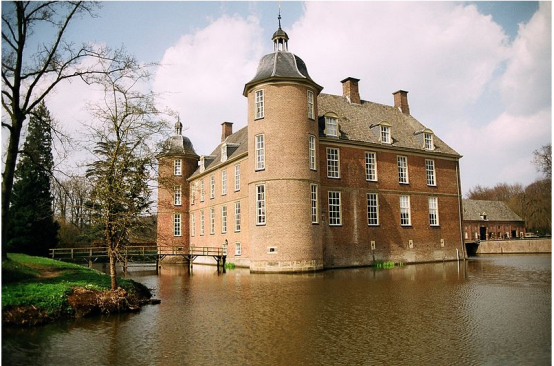
Slangenburg Castle
It is known from archaeological finds of skulls, pottery shards, and flint arrowheads that the area was inhabited more than 11,000 years ago. These prehistoric hunters were followed by Celtic and Germanic tribes like the Franks and Saxons. Roman coins have been found and there is also archaeological evidence of the Vikings having plundered the area.
The first reference to the name of Doetinchem comes in a document from the year 838 which mentions a 'villa Duetinghem', a settlement with a small church. In 887, there is another mention of 'Deutinkem', a fortress with a church which had been given to the then Bishop of Utrecht. The spelling has varied over the centuries, with 'Duttichem', 'Duichingen' and 'Deutekom' being just some examples.
For a long time Doetinchem remained a small place but around 1100 it started to grow and, after suffering several attempts by plunderers, a town wall was built. In 1236, Doetinchem was granted city rights ('stadsrechten') by Count Otto II of Gelre and Zutphen, and in return the town provided taxes and soldiers for the Count's army. Also, the new city council published rules for the city, codified in the 'Keurboek van Doetinchem' (Rulebook of Doetinchem), which laid down severe punishments for infringements.
In 1226, Doetinchem faced increasing danger from plunderers, and so the city wall was raised by a metre. There were four barriers in the wall which, being weak points, were replaced over time by four large city-gates known as: the Hamburgerpoort (built 1302), the Waterpoort, the Gruitpoort, and the Hezenpoort. Later a moat was dug around the wall and a rampart was built in front; the city's central windmill, the 'walmolen' (Dutch 'wal'=rampart, 'molen'=mill), stands on the remains of this rampart. Despite these defences, Doetinchem was besieged many times and during the Eighty Years' War (1568–1648) was besieged and conquered twice. However, eventually the walls became seen as redundant (or perhaps ineffective) and in 1672, they were torn down. However, it was not until the second half of the 19th century that the city-gates and most of the rampart were removed.
From its early years, Doetinchem had been an important marketplace for farmers to sell their wares; the market was held in the central square called the Simonsplein right up until the Second World War.
Doetinchem has had its fair share of disasters. Apart from the sieges mentioned above, in 1527 a large fire destroyed most of the city including the city archives (which means that many earlier dates in the history of Doetinchem are somewhat unreliable), and in 1580 most of the city was killed by plague. There was also occasional flooding. However, despite the fact that Doetinchem is only 10 km (6.2 mi) from the German border, because the Netherlands was not involved in the First World War, Doetinchem saw nothing more than the posting of a few border guards during that time. Even during the Second World War, Doetinchem came off fairly lightly at first; there was only a small German occupying force and the city even escaped the worst effects of the Hunger Winter. However, some prisoners were executed after being implicated in the shooting death in Putten of an important German officer by the Dutch Resistance and disastrously, in March and April 1945, the centre of Doetinchem was largely destroyed by Allied bombing which was either intended for nearby German towns or, as some say, was to destroy the German defenses in Doetinchem. Which of the two is true has never really been clarified and there is still some discussion about the true intentions of the bombardment. The city itself was liberated by The Calgary Highlanders in 1945 after a brief battle there.
In 2018 a writer called Karel Berkhuysen researched about the Allied bombing. He found that the Germans were researching nuclear fission in a converted school. This information was then passed to the Allies.
In the decades after the war, Doetinchem grew and in a few years had outgrown its "competitors" in the Achterhoek, namely Doesburg, Winterswijk and Zutphen. The Dutch company, Philips, had a factory for some years in the city. From 2003 till 2005, the city grew enormously as new districts such as Dichteren were built, and as Doetinchem incorporates outlying villages such as Wehl into its municipality. In 2011, the city is still growing. By building new district as het Loo and Isseldoks, and the opening of a brand new theatre and cinema, Doetinchem is the biggest growing city in Gelderland.
Festivals
Doetinchem has an annual street-theater festival Buitengewoon (Extraordinary), and the City Festival, a big festival with musicacts, theatre, a carnival and fireworks.
VII Other Information
Doetinchem has a professional football team, De Graafschap ('The County'). The home of De Graafschap was completely revamped to transform it into an all-seater arena. The stands are fully covered, with the roof painted in the blue and white of the club.
The city has an indoor swimming pool, Rozengaarde. In April or May, a local evening four-day marathon is organized.
Since 2005 a four-day marathon is organised which starts and ends in Doetinchem and runs through the Achterhoek. The marathon was held from 23 August to the 26th. Almost 15.000 people took part.
In 2009 the city's volleyballteam took part in the CEV cup playing against Haltbank Ankara from Turkey.
VIII Contact
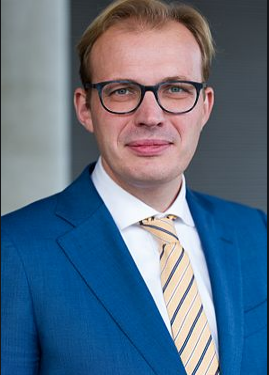
• Mayor Mark Boumans (VVD)
Twitter: Mark Boumans @MarkBoumans
Born: November 13, 1974 (age 45 years), Oosterhesselen, Netherlands
Address: Raadhuisstraat 2, 7001 EW Doetinchem
Telephone (0314) 377 377
Social media:
Facebook: Gemeente Doetinchem@gemeenteDchem
Twitter: gemeente Doetinchem@gemeenteDchem
Youtube: gemeente Doetinchem
Website: https://www.doetinchem.nl/
